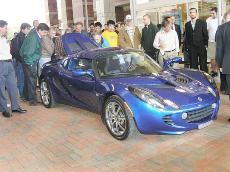
Insight Racing President Grayson Randall’s initial response to Lotus Engineer Simon Cobb’s proposal of replacing the team’s 1987 Suburban with a Lotus Elise was, “But it is so small!”
However, Randall took the offer back to his team, and they decided to make it work. Fitting all of the computers and equipment needed into the tiny vehicle will be a challenge, but one the team is energized about it.
“There are an unlimited number of challenges here, everything from electrical, computer and mechanical,” Randall said. “There is a part of the project for almost everybody.”
Until Wednesday, Insight Racing kept the identity of the new car under wraps. The team knew, but said they diverted publicity so the unveiling on Centennial Campus would be a surprise.
Wednesday, as Dean Louis Martin-Vega of the Engineering school and Cobb stood on a platform speaking about how the “‘E’ in engineering is for excitement,” two Lotus Elises rolled around the traffic circle and onto the brick sidewalk outside of Engineering Building II.
The crowd swayed in excitement as the one red Lotus and the one silver Lotus stood and growled as lone, exotic machines amongst the bricks.
But those two vehicles were only the cause of the enthusiasm for a moment as a voice commanded the crowd to turn around. Through the crowd, a midnight blue Lotus driven by Mike Randall progressed toward the stage. The area filled with clapping as the new Insight Racing vehicle, named the “Lone Wolf,” was presented for the first time.
Ahmed Al-Zawawi, a doctoral student in computer engineering, named the vehicle in a contest sponsored by the engineering school that awarded him with a $500 scholarship.
“The vehicle is autonomous and I was thinking it would be alone in the field, so it would fit nicely,” he said.
The Lone Wolf is an entirely different animal than the old Suburban — named the “Desert Rat” — the team built to crawl across the Mojave Desert. The Lotus is much smaller and closer to the ground — and much more suited to the urban race in which it will be competing in Nov. 2007.
Currently, the exact location for the next Defense Advanced Research Projects Agency challenge is unknown.
“It will be somewhere out West, but the information won’t be released until next year,” Mike Randall, an alumnus in computer science and a member of the Insight Racing team, said.
What has been released are the many difficulties the Lone Wolf must overcome to earn a place on the track. The Desert Rat first competed against 43 other vehicles in preliminary contests to earn a place in the top 23, according to Grayson Randall.
On the day of the competition, the vehicles launched five minutes apart. The Desert Rat made it 26 miles, earning it 12th place out of the original 165 entries.
“If you calculate the cost per mile though, [Insight Racing] would have won,” Robert Fornaro, professor of computer science, said. “What these guys need is more public awareness.”
The final cost of the fully autonomous Suburban totaled $55,000, in a competition of mega-expensive rides. Fornaro speculated that the winning Stanford car cost around $ 4 million.
Sponsorship and University support add a great deal of ability to the Insight team, which is made up of State students, alumni and faculty.
The computer science department has had at least one senior design project team work on a problem for Insight each semester. These problems have included a virtual position tracker, Route GUI and laser radar sensing.
Equipment that will help a midnight blue Lone Wolf navigate the urban wilderness, dodge other cars, park autonomously and obey traffic laws.